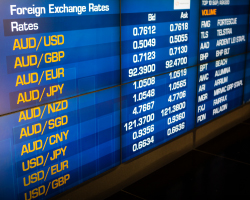Trading Goals: Setting the Foundation for a Successful Trading Day

In the dynamic and fast-paced world of financial markets, every trading day presents a new set of challenges and opportunities. The ability to navigate these fluctuations with confidence and precision often hinges on one crucial factor: well-defined trading goals. As traders embark on their daily journey to decipher market trends and make informed decisions, the practice of setting clear and achievable objectives can make all the difference between success and uncertainty. This article delves into the pivotal role of trading goals and why establishing them before the commencement of each trading day is a fundamental strategy for traders aiming to maximize their gains while effectively managing risk. From seasoned professionals to those just starting, understanding the significance of goal-setting in trading can provide the edge needed to navigate the intricate landscape of financial markets and enhance the overall trading experience.
What Is a Trading Plan?
A trading plan serves as the cornerstone of a trader's journey through the complexities of financial markets. Just as architects meticulously draft blueprints before constructing a building, traders devise trading plans to navigate the intricate world of trading with purpose and strategy. A trading plan is a comprehensive document that outlines a trader's goals, risk tolerance, trading strategies, and guidelines for executing trades. It not only provides a structured approach to trading but also serves as a reference point for making informed decisions amidst the often unpredictable nature of the markets.
This aims to clarify the assets that a trader or investor will engage with. Some traders specialize in stocks, whereas others concentrate on commodities, forex, and exchange-traded funds.
The 'why' articulates the motivations behind a specific trade, while the 'when' determines the optimal timing for executing the trade or investment. Lastly, the 'how' elucidates the step-by-step process through which the trade is carried out.
A comprehensive trading plan must address each of these inquiries.
The Quintessential Illustration: Warren Buffett
Every accomplished trader and investor adheres to a robust strategy when it comes to executing trades. Take Warren Buffett as an instance; he consistently considers several pivotal factors before embarking on an investment.
To begin with, his primary focus lies on value stocks. Over a span of more than sixty years, he has steered clear of domains in which he lacks substantial insight, such as growth stocks and cryptocurrencies.
Furthermore, he never engages in an investment without a clear rationale. In most scenarios, his acquisitions revolve around companies he perceives as significantly undervalued, ones harboring considerable potential for returns. He also directs his attention toward enterprises fortified by a robust competitive advantage, exemplified by brands like Coca-Cola and Moody's.
Moreover, Buffett adheres to the principle of entering the stock market under opportune circumstances. As an illustration, in 2022, he acquired shares of Occidental Petroleum when the prices of crude oil and natural gas experienced a notable upsurge.
Collectively, the practices of Buffett and other immensely prosperous investors in the field are underscored by meticulous planning, which fundamentally contributes to their achievements.
The Significance of Goal Planning
A trading plan serves as a critical instrument that delineates whether your trajectory as a trader will culminate in success. However, its efficacy is contingent upon aligning it with your objectives.
While the daily aim invariably revolves around profit generation, it's essential to shift our focus. Instead, we should contemplate the route to our objectives and the advantages we can derive from it.
In crafting pragmatic daily trading goals, it's paramount to assess your risk tolerance and strive for attainable targets. Emphasize the maintenance of consistency and motivation by setting pragmatic profit benchmarks. This might entail aiming for a specific percentage gain or a predetermined number of successful trades.
This approach serves to avert excessive trading and steers you resolutely towards sustained, long-term trading triumph.
The same principle applies when embarking on a trading career. The emphasis shouldn't be solely on 'trading for greater financial gains,' but rather on the conscious choice to pursue this vocation.
For a trading goal, and by extension, any objective, to hold relevance, it must be SMART: Specific, Measurable, Achievable, Relevant, and Time-bound. Let's delve into some key rationales for establishing trading goals.

Attaining Trading Success
Primarily, a trading goal serves as the cornerstone for becoming a more accomplished trader. The example of Warren Buffett underscores the fact that individuals who adhere to a systematic trading approach tend to achieve superior outcomes compared to those who don't.
Consequently, addressing all the pertinent questions paves the way for substantial success in your trading endeavors.
Streamlining Your Trading
Formulating a trading plan with well-defined goals streamlines your trading process. By virtue of possessing a systematic strategy, you're equipped to navigate diverse market scenarios.
This translates to a simplified decision-making process concerning purchases and short positions. Most significantly, you're not perpetually ensnared in the quest for a functional strategy.
Sustaining Focus
Simultaneously, a trading plan serves as a lodestar that keeps you focused within the market. Concentration is a pivotal facet of trading; individuals with heightened focus typically fare better.
For instance, addressing the aforementioned queries aligns your concentration with crucial aspects such as what, how, why, and when.
On the contrary, embarking on a trading day devoid of a pre-established goal (whether centered around specific stock types, pertinent news, or trade quotas) dissipates your energy.
Actualizing Objectives
Most significantly, a well-constructed trading plan serves as a catalyst for realizing your trading aspirations. As a trader, the primary objective is augmenting returns on investments.
Simultaneously, external objectives play an integral role. These might encompass fostering a balanced lifestyle, enhancing performance, and carving out more time for personal passions.

Drawbacks of Setting Inappropriate Goals
A prevalent hurdle often encountered is the establishment of impractical objectives within one's trading journey. Such circumstances typically give rise to a multitude of challenges. Here are some prominent reasons that underscore the potential pitfalls of veering off course with your trading goals.
Unattainable Objectives
Foremost, a recurrent obstacle faced by traders is the establishment of goals that are overly ambitious. As an illustration, envision the scenario where an individual aspires to escalate their $10,000 account to $1 million within a mere month.
While this outcome isn't entirely implausible, it remains an exceedingly challenging feat. Notably, even the most accomplished traders globally grapple with the realization of such aspirations.
Pursuing unattainable goals may inadvertently lead to significant losses within the market. For instance, achieving a growth from $10,000 to $1 million necessitates deploying substantial leverage. Moreover, it mandates the execution of exceptionally large-scale trades, a practice fraught with considerable risk.
Excessive Trading
Activity Another consequence of setting unrealistic objectives is the inclination towards over-trading. Over-trading entails the frequent initiation of numerous trades within a single day.
While a high frequency of trades can yield substantial profits, it equally exposes one to heightened risk. Frequently, the surplus of trades results in greater exposure to losses as opposed to gains.
Stagnation in Personal Growth
Concurrently, fostering unfeasible goals can foster detrimental stagnation within your trading journey. An adverse outcome of this phenomenon is a cessation of the ongoing process of enhancing your trading strategies and methods.
Given the perpetual flux characterizing the market, abstaining from continuous learning and refinement of strategies can have detrimental consequences.
In a realm where adaptability is key, failing to evolve and refine one's approaches can prove to be counterproductive.
Illustrative Instances of Vital Trading Goals
A spectrum of essential trading goals exists, each integral to your success within the market. Here are several examples that warrant your attention:
Regularly Update Your Trading Journal
Maintaining a comprehensive trading journal is imperative. This record chronicles all pertinent details of your trades and can exist in either digital or physical form.
Key components that should populate your trading journal encompass the opening and closing prices of trades, the rationale behind initiating each trade, precise timestamps for entry and exit, and the factors influencing your decision to exit.
Typically, your journal should seamlessly address the fundamental questions highlighted earlier. However, it's not uncommon for the task of journaling to fall by the wayside.
Attain Work-Life Equilibrium
Another pivotal facet underlining the significance of trading goals pertains to achieving a harmonious balance between your trading commitments and personal life.
For instance, setting a goal of dedicating a mere four hours to trading daily translates to a substantial chunk of unoccupied time, affording you the luxury to pursue your passions and devote more moments to familial bonds.
Determine Maximum Permissible Loss
Yet another exemplar of a worthwhile goal revolves around defining the utmost allowable loss per trade.
Consider setting a goal not to exceed a 2% loss of your account balance per individual trade. Such a parameter profoundly contributes to your proficiency as a trader.
Ultimately, these examples signify the pivotal role that meticulous goal-setting plays in steering your trading journey toward prosperity.
Conclusion
Wrapping up, we can say that the importance of setting clear and achievable trading goals cannot be overstated. These goals form the bedrock upon which successful trading journeys are built. From meticulous planning to navigating market fluctuations with poise, trading goals provide the roadmap to success. By adhering to these objectives, traders can find a sense of direction amidst the chaos, make informed decisions, and adapt to the changing landscape. Regardless of experience level, recognizing the power of goal-setting in trading can truly be the defining factor that separates triumph from uncertainty. In the end, trading goals not only maximize gains and mitigate risks but also enhance the overall trading experience, making them an indispensable tool in the arsenal of every trader.

About AdroFx
Established in 2018, AdroFx is known for its high technology and its ability to deliver high-quality brokerage services in more than 200 countries around the world. AdroFx makes every effort to keep its customers satisfied and to meet all the trading needs of any trader. With the five types of trading accounts, we have all it takes to fit any traders` needs and styles. The company provides access to 115+ trading instruments, including currencies, metals, stocks, and cryptocurrencies, which make it possible to make the most out of trading on the financial markets. Considering all the above, AdroFx is the perfect variant for anyone who doesn't settle for less than the best.











